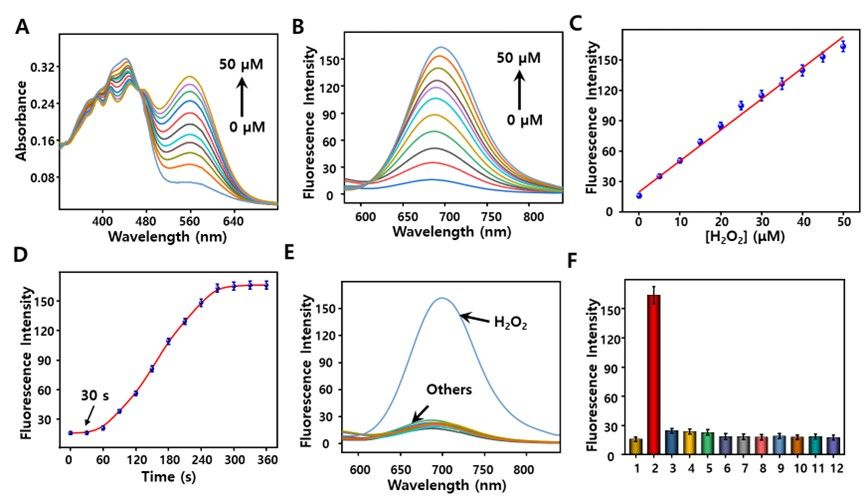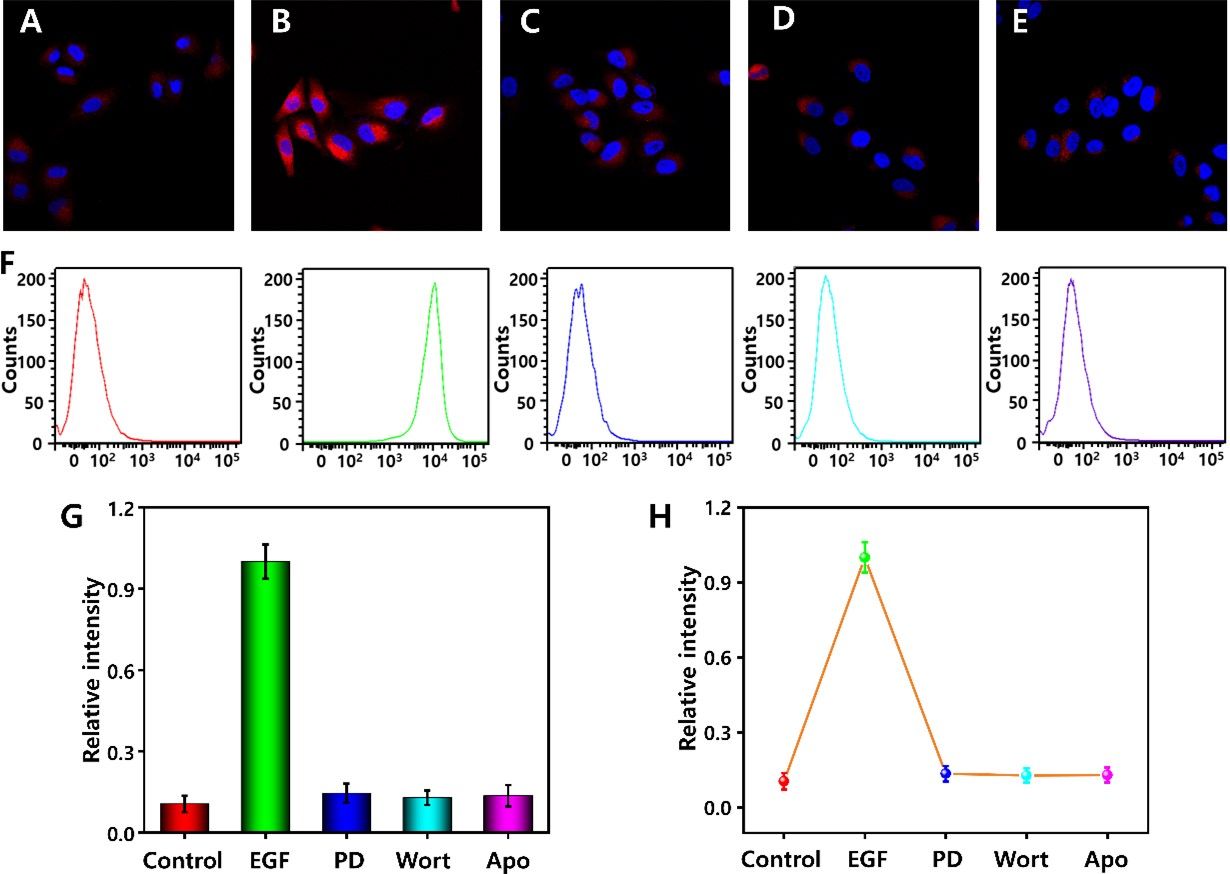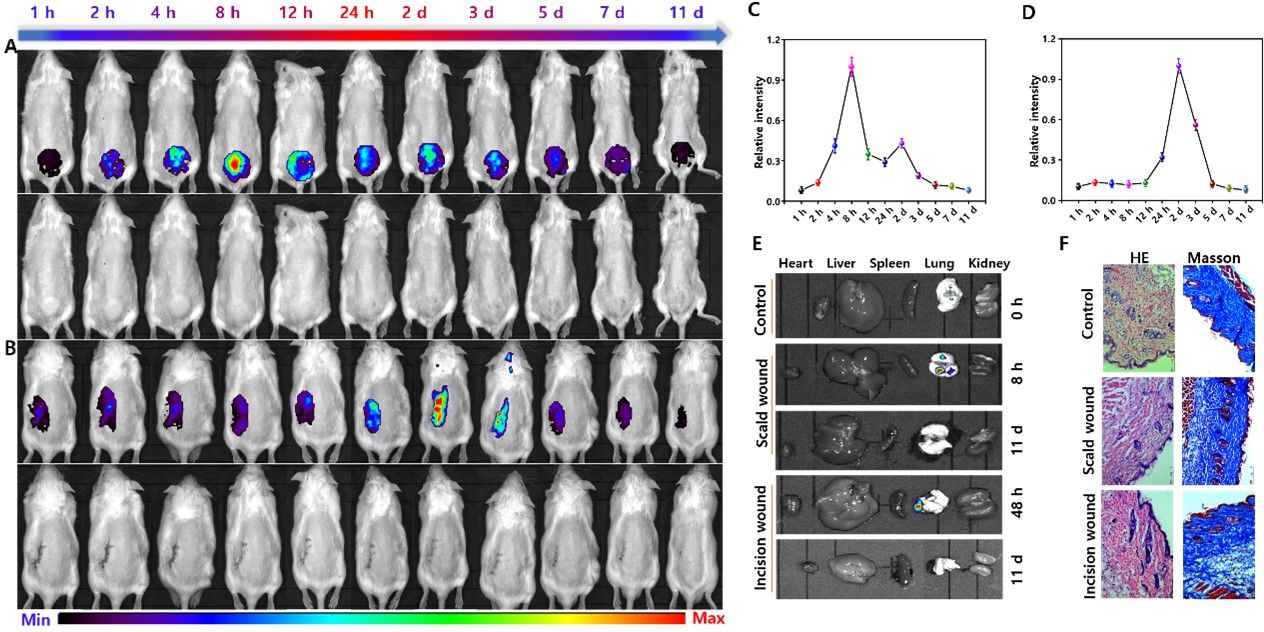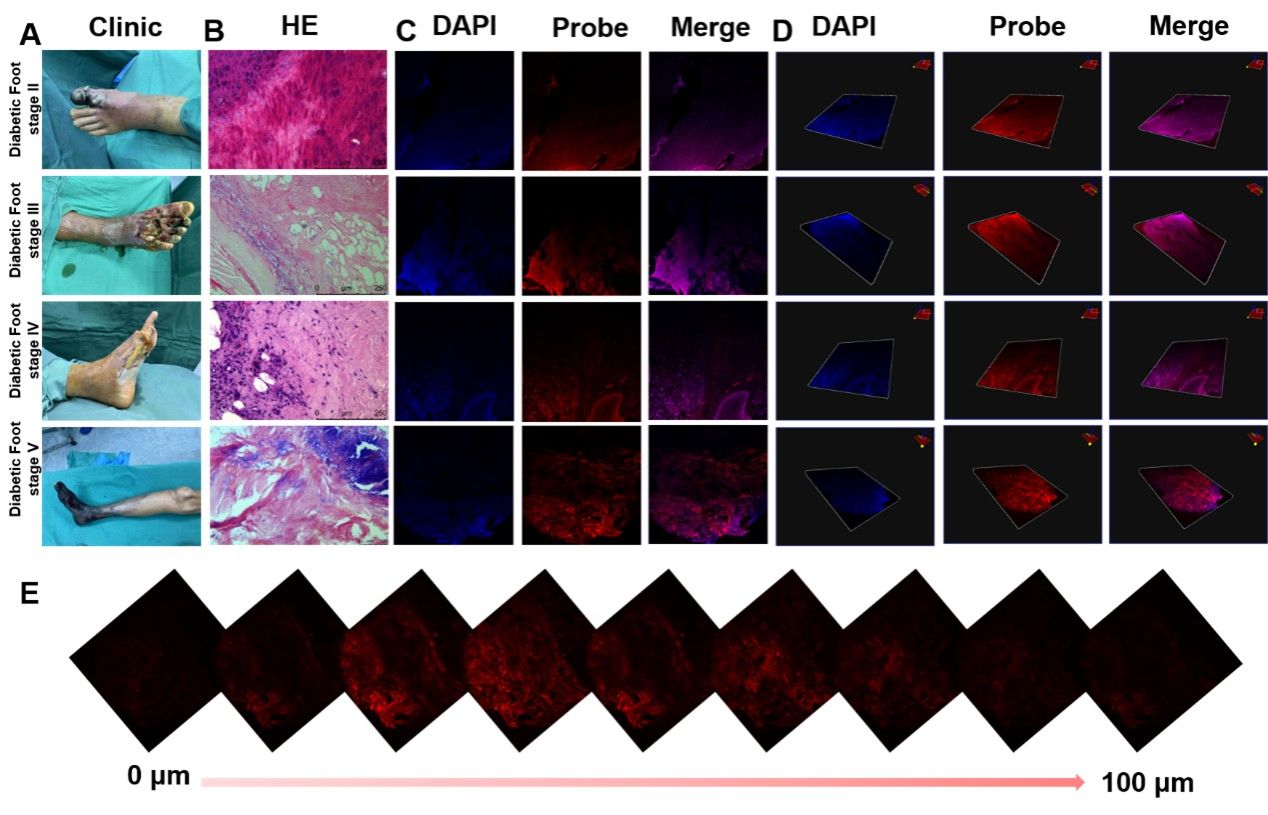博文
Fluorescence Probe for Pathological Stages of Wound Healing
|
Near-Infrared Fluorescence Probe for Indication of the Pathological Stages of Wound Healing Process and Its Clinical Application
Xianzhu Luo【罗贤柱】,Shaowen Cheng【程少文】,Wei Zhang【张伟】,Kun Dou【窦昆】,Rui Wang【王锐】*, and Fabiao Yu【于法标】*
a Key Laboratory of Hainan Trauma and Disaster Rescue, Department of Wound Repair, The First Affiliated Hospital of Hainan Medical University, Hainan Medical University, Haikou 571199, China
b Engineering Research Center for Hainan Bio-Smart Materials and Bio-Medical Devices, Key Laboratory of Emergency and Trauma, Ministry of Education, Key
Laboratory of Hainan Functional Materials and Molecular Imaging, College of Emergency and Trauma, Hainan Medical University, Haikou 571199, China
Cite this: ACS Sens. 2024, 9, 2, 810–819
Publication Date:January 19, 2024
https://doi.org/10.1021/acssensors.3c02147
Copyright © 2024 American Chemical Society
SUBJECTS: Fluorescence,Fluorescence imaging,Probes,Rodent models,Wound healing
AbstractChronic wound healing is one of the most complicated biological processes in human life, which is also a serious challenge for human health. During the healing process, multiple biological pathways are activated, and various kinds of reactive oxygen species participate in this process. Hydrogen peroxide (H2O2) involves in chronic wounds and its concentration is fluctuated in different pathological stages during the wound healing process. Therefore, H2O2 may be recognized as a powerful biomarker to indicate the wound healing process. However, the pathological roles of H2O2 cannot be fully understood yet. Herein, we proposed a near-infrared fluorescent probe DCM-H2O2 for highly sensitive and rapid detection of H2O2 in living cells and scald and incision wound mice models. DCM-H2O2 exhibited a low detection limit and high specificity with low cytotoxicity for H2O2, which had great potential for its application in vivo. The probe was successfully utilized to monitor the fluctuation of endogenous H2O2 in the proliferation process of human immortalized epidermal (HACAT) cells, which confirmed that H2O2 participated in the cells’ proliferation activity through a growth factor signaling pathway. In the scald and incision wound mice models, H2O2 concentration fluctuations at different pathological stages during the wound healing process could be obtained by in vivo fluorescence imaging. Finally, H2O2 concentrations in different stages of human diabetic foot tissues were also confirmed by the proposed probe. We expect that H2O2 could be a sensitive biomarker to indicate the wound healing process.

KEYWORDS:
near-infrared fluorescence imaging hydrogen peroxide fluctuation diabetes mellitus wound healing clinical sample test
Introduction
Chronic wound healing remains a global challenge and one of the major common public health problems that cannot be ignored [1-3]. It is a complex physiological process that consists of hemostasis, inflammation, proliferation and remodeling [4, 5]. Unfortunately, bacterial infection or other diseases (destructive irriation, diabetes mellitus) may interfere with wound healing, leading to impaired structural and functional regeneration of entire skin tissue, which in turn may lead to severe disability and even increased mortality [6, 7]. Therefore, monitoring changes in physiological parameters during wound healing is crucial to understand the state and physiological process of wound healing, which can help identify wound infections and subsequent treatment. The current clinical evaluation of wounds healing mainly focuses on planimetry to quantitatively detect the changes of wound size and granulation tissue formation. Although this method can reflect the macroscopic changes in the wound, it cannot show the regulation at the molecular level.
Excessive infiltration of neutrophils appears to be one of the culprits of chronic wound healing [8]. Abundant ROS in neutrophils is involved in all phases of wound healing, which can cause oxidative stress and adversely affect wound healing even prevent new tissue formation [9-12]. As a critical member of ROS, hydrogen peroxide (H2O2) has been considered as an intracellular second messenger, which plays key roles in various physiological processes including cell growth, inflammation treatment, proliferation and differentiation, and activation of immune cells [13-15]. The previous researches indicate that H2O2 involves in wound healing and its concentration is fluctuated in different pathological stages during the wound healing process [16-20]. Therefore, H2O2 may be considered as a powerful biomarker to indicate the chronic wound healing process.
Although visual observation is the simplest and most versatile means of initial diagnosis of chronic wounds, it relies on the certain clinical experience and cannot predict the effect of treatment and the stage of healing [21]. Therefore, there is an urgent need to develop rapid and sensitive tools to detect H2O2 to accurately identify the various states of chronic wound healing [22]. Recently, fluorescent probes have been considered as powerful tools to monitor biological active species and processes due to their non-invasiveness, high sensitivity, and excellent spatial and temporal resolution [23-29]. Some fluorescent probes have been reported for monitoring H2O2 in living cells and in vivo through the careful design; however, the probes for monitoring the concentration fluctuation during the chronic wound healing process are still challenging [30-34]. Moreover, compared to the fluorescent emission in the visible light region, fluorescent probes with excitation/emission wavelength in the near-infrared (NIR) region get benefit from the low background interference, small light damage and deep penetration, which are more suitable for bioimaging [35-37]. With this in mind, we attempt to develop a NIR fluorescent probe for rapid and highly sensitive detection of H2O2 in living cells and in vivo to track the concentration fluctuations of H2O2 during the chronic wound processes.
Herein, we proposed a NIR fluorescent probe DCM-H2O2 with large Stokes shift for investigating the fluctuation of H2O2 level during chronic wound healing process in wound mice models and human diabetic foot tissues. The probe comprised of pentafluorobenzenesulfonyl ester group as recognition moiety of H2O2 and dicyanomethylene-benzopyran (DCM) as NIR fluorophore. In the presence of H2O2, DCM-H2O2 exhibited rapid response to H2O2 with large Stokes shift, emitting a brilliant fluorescent signal at 695 nm. Furthermore, DCM-H2O2 displayed low cytotoxicity and excellent biocompatibility. Then, the proposed probe was applied to monitor the fluctuations of H2O2 level during the healing process of scald and incision wound mice models and in various pathological stages of the human diabetic foot, which contributed to comprehend the role of H2O2 in the physiological process. The probe could act as an effective tool to help diagnose the various stages of chronic wound healing that assisted with further treatment.

Scheme 1. The molecular structure of DCM-H2O2 and its proposed response mechanism towards H2O2.

Figure 1. The spectral properties and selectivity of DCM-H2O2. (A) The UV-Vis absorption spectra of DCM-H2O2 toward H2O2 (0 - 50 µM) for 5 min in PBS (pH =7.4, 10 mM, PBS: DMSO=7:3, v/v). (B) The fluorescence emission spectra of DCM-H2O2 toward H2O2 (0 - 50 µM) for 5 min in PBS (pH=7.4, 10 mM, PBS: DMSO=7:3, v/v). (C) The linear relationship between the fluorescence intensity of DCM-H2O2 and various levels of H2O2. (D) Time-dependent fluorescent intensity toward H2O2 during 0 - 360 s, and the probe was added at 30 s. (E) The fluorescence spectra of DCM-H2O2 toward other analytes. (F) The fluorescent response of DCM-H2O2 to various reactive species at 10 min: 1. blank; 2. H2O2; 3. ONOO-; 4. HNO; 5. NO; 6. ·OH; 7. tBuOO·; 8. O2·-; 9. OCl-; 10. Cys; 11. GSH; 12. Hcy. The experiments were repeated three times and the data were shown as mean (± S.D.).

Figure 2. Fluorescence imaging of endogenous and exogenous H2O2 in living cells. (A) Fluorescent imaging of exogenous H2O2 in HeLa cells at different time points: 0 min, 5 min, 10 min, 20 min and 30 min. (B) Fluorescent imaging of exogenous H2O2, HClO and ONOO- in RAW 264.7 cells. The RAW 264.7 cells were treated with H2O2 (10 µM, 30 µM), ClO- and ONOO- donor (SIN-1), and then incubated with probe (10 µM), respectively. (C) Fluorescent imaging of endogenous H2O2 in RAW 264.7 cells. Control group: RAW 264.7 cells was incubated with the probe DCM-H2O2; PMA group: The RAW 264.7 cells were treated with PMA (1 μg/mL) for 6 h and then incubated with the probe DCM-H2O2; PMA + NAC group, PMA+ebselen, and PMA+L-NAME group: the cells were preincubated with NAC (1 mM), ebselen (5 μM), and L-NAME (5 mM) and then tread with probe, respectively. (D-F) Relative mean fluorescent intensities in A-C. Fluorescence collection windows for red channel: λex = 561 nm, λem = 650 - 730 nm and blue channel (DAPI): λex = 405 nm, λem = 420 - 480 nm. The experiments were repeated five times and the data were shown as mean (± S.D.).

Figure 3. Fluorescence images and flow cytometry analysis of H2O2 in HACAT cells via DCM-H2O2. (A) The cells were treated with the probe DCM-H2O2 (10 μM). (B) The cells were incubated with EGF (500 ng/mL) for 30 min and then treated with probe. (C) The cells loaded with DCM-H2O2 were pretreated with PD153035 and then stimulated with EGF. (D) The cells loaded with DCM-H2O2 were pretreated with wortmannin and then stimulated with EGF. (E) The cells loaded with DCM-H2O2 were pretreated with apocynin before stimulated with EGF. (F) The flow cytometry analysis of the cells in A-E. (G) Relative mean fluorescent intensities in A-E. (H) Relative mean fluorescent intensities in F. The fluorescence collection windows for red channel (DCM-H2O2): λex = 561 nm, λem = 650 - 730 nm and blue channel (DAPI): λex = 405 nm, λem = 420 - 480 nm. The experiments were repeated five times and the data were shown as mean (± S.D.).

Figure 4. Time-dependent fluorescence images of H2O2 in wound healing models. (A) Fluorescence images of H2O2 with DCM-H2O2 in healing process of scald wound mouse model at different time points (1 h, 2 h, 4 h, 8 h, 12 h, 24 h, 2 d, 3 d, 5 d, 7 d and 11 d). (B) Fluorescence images of H2O2 with DCM-H2O2 in healing process of incision wound mouse model at different time points (1 h, 2 h, 4 h, 8 h, 12 h, 24 h, 2 d, 3 d, 5 d, 7 d and 11 d). (C) Relative mean fluorescent intensities in A. (D) Relative mean fluorescent intensities in B. The fluorescence collection windows for red channel: λex = 561 nm, λem = 650 - 730 nm. The experiments were repeated five times and the data were shown as mean (± S.D.). (E) The fluorescence detection of vitro vital organs (from left to right: heart, liver, spleen, lung, and kidney). (F) H&E and Masson staining for normal mice skin, period of inflammation of scald mice skin (8 h) and incision mice skin (48 h).

Figure 5. Fluorescent imaging in the tissues of the different physiological stages of the human diabetic foot. (A) Photographs of clinical samples. (B) H&E staining. (C) Fluorescence imaging of lesion skin tissues at lesion stages. The fluorescence collection windows for red channel: λex = 561 nm, λem = 650 - 730 nm. (D) Three-dimensional (3D) images of (B). (E) Mapping of Z-line sequential images for dysplasia slice at a depth interval of 10 μm (diabetic foot stage V).
4. Conclusion
In summary, we reasonably designed and synthesized a NIR probe (DCM- H2O2) to track the concentration fluctuations of H2O2 during the scald and incision wound healing process and the human diabetic foot tissues. The probe exhibited high sensitivity and specificity, and can respond quickly to H2O2. DCM-H2O2 was employed to detect exogenous and endogenous H2O2 and investigated the fluctuation of H2O2 during the proliferation of HACAT cells. Furthermore, the real-time imaging of H2O2 in the process of scald and incision wound mice models strongly demonstrated that the proposed probe could track the concentration fluctuations of H2O2 during the wound healing process. This study is helpful to better understand the role of H2O2 in wound healing process. Furthermore, the probe was employed to image H2O2 in clinical diabetic foot samples, providing a new strategy for differentiating the pathological stages of the diabetic foot.
https://blog.sciencenet.cn/blog-2438823-1423565.html
上一篇:Macrophage M2 polarization to neurological damage
下一篇:Fluorescent Probe forRatiometric Monitoring of Peroxynitrite